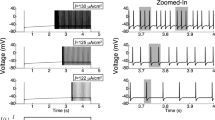Abstract
Understanding the nonlinear dynamics of an olfactory bulb (OB) is essential for the modelling of the brain and nervous system. We have analysed the nature of odour-receptor interactions and the conditions controlling neural oscillations. This analysis is the basis for the proposed biologically plausible three-tiered model of an oscillation-driven neural network (ODNN) with three non-linearities. The layered architecture of the bulb is viewed as a composition of different processing stages performing specific computational tasks. The presented three-tiered model of the olfactory system (TTOS) contains the sensory, olfactory bulb and anterior nucleus tiers. The number of excitatory (mitral/tufted) cells differs from the number of inhibitory (granule) cells, which improves the cognitive ability of the model. The odour molecules are first received at the sensory layer, where receptor neurons spatio-temporally encode them in terms of spiking frequencies. Neurons expressing a specific receptor project to two or more topographically fixed glomeruli in the OB and create a sensory map. Excitatory postsynaptic potentials are formed in the primary dendrite of mitral cells and are encoded in an exclusive way to present them to the coupled non-linear oscillatory model of the next mitral-granule layer. In a noisy background, our model functions as an associative memory, although it operates in oscillatory mode.
While feed-forward networks and recurrent networks with symmetric connections always converge to static states, learning and pattern retrieval in an asymmetrically connected neural network based on oscillations are not well studied. We derive the requirements under which a state is stable and test whether a given equilibrium state is stable against noise. The ODNN demonstrates its capability to discriminate odours by using nonlinear dendro-dendritic interactions between neurons. This model allows us to visualise and analyse how the brain is able to encode information from countless molecules with different odour receptors.
















Similar content being viewed by others
References
Bower JM, Beeman D (1998) The Book of Genesis, 2nd edn. Springer, Berlin Heidelberg New York
Dulac C, Axel R (1995) Novel family of genes encoding putative pheromone receptors in mammals. Cell 83:195–206
Freeman WJ (1987) Simulation of chaotic EEG patterns with a dynamic model of the olfactory system. Biol Cybern 56:139–150
Freeman WJ (in press) Olfactory system: odorant detection and classification. In: Amit D, Parisi D (eds) Building blocks for intelligent systems: brain components as elements of intelligent function, Academic Press, New York
Georgiev G, Gueorguieva N, Tchimev P and Valova I (2001) Odor information processing in human-oscillatory model. Proc IEEE Sys Man Cybern 1:52–58
Getchell TV, Shepherd GM (1978) Responses of olfactory receptor cells to step pulses of odor at different concentrations in the salamander. J Physiol 282:521–540
Getchell TV, Shepherd GM (1978) Adaptive properties of olfactory receptors analyzed with odor pulses of varying duration. J Physiol 282:541–560
Gueorguiev G (2002) Modeling the sensory computations of olfactory bulb system. In: Proceedings of the 5th IASTED International Conference on Computer Graphics and Imaging, Special Session on Medical Imaging and Visualization, Hawaii, USA, August 2002
Gueorguieva N, Valova I and Georgiev G (2001) Dynamic modeling of behavior of central olfactory system: simulation analysis and information processing. In: Dagli C et al. (eds) Intelligent engineering systems through artificial neural networks, ASME Press, New York
Karim M, Gueorguieva N and Valova I (2001) Nonlinear simulations of olfactory systems. In: Proceedings of the Fall 2001 Regional Conference “The 21st Century Engineer”, New York, NY, 2–3 November 2001
Koch C, Segev I (1998) Methods in neuronal modeling: from ions to networks, 2nd edn. MIT Press, Cambridge, MA
Laurent G, Davidowitz H (1994) Encoding of olfactory information with oscillating neural assemblies. Science 265:1872–1875
Li Z, Hopfield JJ (1989) Modeling the olfactory bulb and its neural oscillatory processing. Biol Cybern J 61:379–392
Li Z (1995) Modeling the sensory computation of the olfactory bulb. In: van Hemmen JL, Domany E and Schulten K (eds) Models of neural networks, 2:221–251
Mombaerts P, Wang F, Dulac C et al. (1996) Visualizing an olfactory sensory map. Cell 87:675–686
Murphy C (2002) Olfactory functional testing: sensitivity and specificity for Alzheimer’s disease. Drug Devel Res 56(2):123–131
Shepherd GM (1998) The synaptic organization of the brain. Oxford University Press, New York
Schoppa NE, Westbrook GL (2001) Glomerulus-specific synchronization of mitral cells in the olfactory bulb. Neuron 31:639–651
Valova I, Georgieva N and Tchimev P (2000) Modelling the olfactory bulb information processing activity with oscillatory neural networks. In: Dagli C et al. (eds) Intelligent engineering systems through artificial neural networks 10:831–837
Vassar R, Chao SK, Sitcheran R, Nunez JM, Vosshall LB and Axel R (1994) Topographic organization of sensory projections to the olfactory bulb. Cell 79:981–991
Acknowledgements
This work is funded in part by the UMD Foundation grant #UMDF- 525360 “Modelling Of Odour Information Processing In The Human Brain—Nonlinear Simulations Of The Olfactory System” of the University of Massachusetts Dartmouth, PSC-CUNY Awards #61782–00–30, #63374–00–32, GRTI’01 grant “Human-Brain Modelling and Simulations”.
Author information
Authors and Affiliations
Corresponding author
Rights and permissions
About this article
Cite this article
Valova, I., Gueorguieva, N. & Kosugi, Y. An oscillation-driven neural network for the simulation of an olfactory system. Neural Comput & Applic 13, 65–79 (2004). https://doi.org/10.1007/s00521-003-0392-x
Received:
Accepted:
Published:
Issue Date:
DOI: https://doi.org/10.1007/s00521-003-0392-x




